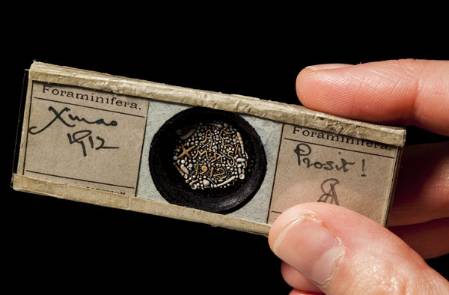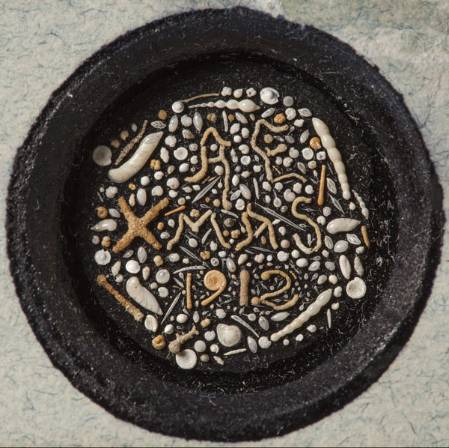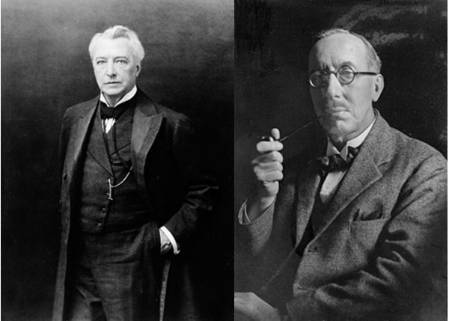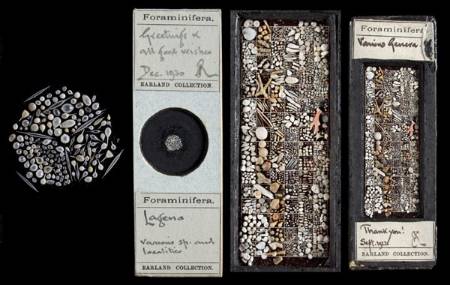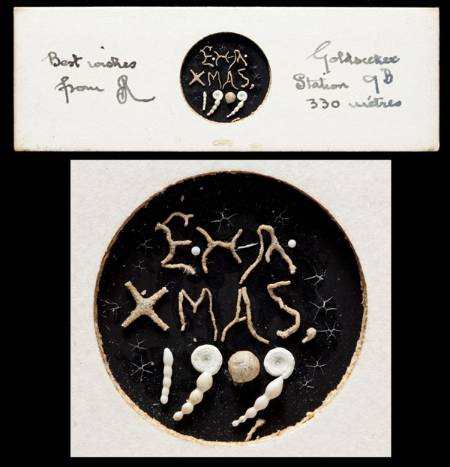Last year I posted some images of microfossils sent as Christmas cards by Arthur Earland (1866-1958) to his collaborator Edward Heron-Allen (1861-1943). Following my post I was contacted by Brian Davidson who now owns Arthur Earland's collection. He visited the Museum in October and brought with him some fine examples of Arthur Earland's foraminiferal slides. It is 100 years since the creation of one of the Museum slides and the story of Earland and Heron-Allen, their collaboration and their subsequent falling out has been published in The Independent newspaper and subsequently the BBC Focus web site.
The slide of Foraminifera made by Arthur Earland for Edward Heron-Allen in 1912.
How were they made?
Each individual specimen was positioned with a fine paint brush and glued down with gum Tragacanth by Arthur Earland. The specimens are Foraminifera; single celled organisms that mainly form shells of calcium carbonate with one or many openings. The sandy looking lettering on the slide is made mainly from tube shaped agglutinating Foraminifera of the genus Rhabdammina that gathers fine sediment from the sea floor to create a shelter for the single celled organism.
Why were they made?
Arthur Earland made them as gifts for his collaborators and aquaintances. He collaborated with Edward Heron-Allen for over 25 years, including a publication on the Foraminifera of the 1910-1913 Antarctic expedition of the Terra Nova (also known as Scott's Last Expedition). The specimens were chosen to show the amazing range of morphologies of the Foraminifera. Other slides in the collection show assemblages from particular samples, for example dredgings from the Challenger Expedition.
Portraits of Heron-Allen and Earland now hanging in the Museum's micropalaeontology library, The Heron-Allen Library.
Arthur Earland
Earland was a high-ranking civil servant who made a career working for the Post Office Savings Bank. Earland and Heron-Allen shared a room at the British Museum (Natural History) where they were able to work on the Foraminifera in an unpaid capacity. Earland's private collection is now owned by Brian Davidson who bought it from Brigadier H. G. Smith who had obtained it from the Estate of F. W. Mills in 1952. Earland must therefore have disposed of his collection well before his death in 1958. Foraminiferal slides made by Earland have been recorded in Ireland and also in Scotland where he went to live after his falling out with Heron-Allen. Brian Davidson has a listing for a 1,500 specimen slide made by Earland that has not been located in any museum collection.
Edward Heron-Allen
Heron-Allen, a Lawyer by profession, also had an unpaid position at the British Museum (Natural History). He was responsible for gathering much of the early microfossil collection as well as a vast library of foraminiferal books which he donated to the Museum in 1926. They are now housed, along with more recent microfossil library acquisitions, in the 'Heron-Allen Library'. The web site of the Heron-Allen Society lists his interests: violin making, palmistry, Persian texts, Selsey, esoteric fiction and asparagus. A number of publications detailing Heron-Allen's interests are available via the society.
The "Christmas card" slide made in 1930 and a 1922 "Thank you" slide made by Arthur Earland for Edward Heron-Allen. The 1930 slide contains far fewer specimens than some made in the 1920s that fill the whole cavity. This may represent a waning of their relationship by this time.
Why did they fall out?
In the early 1930s their long collaboration ended suddenly. Anecdotal evidence suggests they visited the Museum to work on different days after this to avoid seeing each other. Historical data and two key pieces of evidence in the Museum archives suggest a number of factors in the deterioration of their personal and professional relationship:
- Poor health
At the time both Heron-Allen and Earland were in poor health. Heron-Allen was devastated by the tragic death of his youngest daughter Armorel in a car accident in 1930 while Earland had angina and was unhappy at being passed over for the position of controller of the Post Office Savings Bank.
- Authorship on a publication
Part 2 of the monograph on the Discovery Foraminifera published by Earland in 1933 tells an interesting story. Part 1 had been published jointly by Heron-Allen and Earland but a note in part 2 states "Owing to illness, my colleague Edward Heron-Allen was unable to take as large a share as usual in the preparation of this report. At his own request, and against my wish, his name is omitted from the authorship".
Heron-Allen's personal copy of the monograph tells a different story. A handwritten note, that subsequently had several layers of paper stuck over it, reads; "I had my name removed from the titles of this paper, when, on my return from Ceylon in 1931 I found that Earland had claimed all my work upon it as his own, and that, not having knowledge of the German language, he had ignored Hans Wiesner's report on the 'Süd-Polar Expedition' in which (in my opinion) most of his new genera and species are described and figured."
- Division of labour
The Museum archives contain a letter written in Edinburgh in 1943 from Earland to Ovey, who was then curator of Foraminifera at the Museum. It itemises in great detail exactly who did what during their association. It would appear that Earland did most of the slide related work while Heron-Allen did the writing, often using his personal wealth to encourage editors to accept their manuscripts for publication (In the Heron-Allen Library we have the receipts for various bills paid relating to illustrations and publishing).
What is certain is that Earland's collection does not contain any "Christmas Card Slides" from Heron-Allen. Either they were never made or they were destroyed by Earland. The collection's owner Brian Davidson tells me that any references to Heron-Allen on the slides have also been scored out.
- Jealousy and recognition
It is clear from the 1943 letter that Earland was jealous of Heron-Allen who had all the connections and the money to pay for publications while Earland felt that he was the one doing the work. He may have had a point as all their papers were by Heron-Allen and Earland with Earland's name never as first author. Heron-Allen had also been elected a Fellow of the Royal Society in recognition of his work on the Foraminfera.
- A female acquaintance
The 1943 letter states that everything was fine until "that final woman" came around. Heron-Allen was a very charismatic and popular figure and often had an entourage of young females. It would appear that one of them may have been involved in the rift between the two scientists. The 2012 Annual Meeting of the Heron-Allen Society was entitled "Edward Heron-Allen and some women of his acquaintance"!
Earland's mounting skill, diligence and Heron-Allen's writing, connections and money was a fruitful combination for 25 years. Many publications and the accumulation of the best foraminiferal collection and library of the time was the result. The Heron-Allen and Earland Collection is the backbone of the current collection, in which the 1912 Christmas Card slide is one of the most treasured items. Happy 100th anniversary of the sending of this microfossil Christmas card and more importantly, Happy Christmas to you all!



